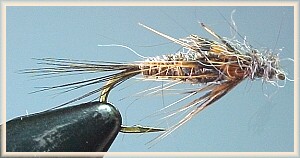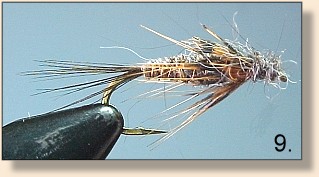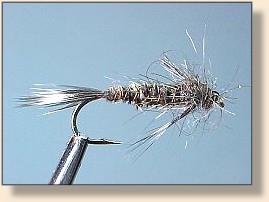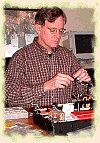
 |
|
The Black Dog Nymph
|
 Step 5. Wrap the wire rib forward in even spirals. Because I counter-wrapped the turkey fibers, the rib wraps across the fibers, adding durability to the fly.
 Step 6. Tie in a hen feather by the tip.
 Step 7. Wrap the hackle around the shank 3 times, stroking the fibers back toward the bend.
 Step 8. This next step will make many cringe. If so, you can stop at step 7 and have a wonderful soft hackle wet fly. But if you are willing to take the next step, trim the top hackle fibers with scissors so they are about the length of a wing case. As the nymph tumbles along in the stream, I believe this gives an overall appearance of legs and wingcase all mixed together.
 Step 9. Dub enough of your thread to make several wraps of dubbing in front of the hackle. One or two wraps should go over the base of the hen hackle collar to help the fibers lie a bit flatter against the body.
 Above is the original.
Variations:
 Size 16 pheasant tail body, brown hen hackle, and brown poly dubbing.
 Size 14 beadhead, tan peacock herl body, badger hen hackle, and tan squirrel dubbing. Note that the tail is made from the marabou-type fibers from the base of a hen feather.
 Size 12 peacock herl body, black hen hackle, and black hare's ear dubbing.
 Size 12 tan peacock herl body, orange hen hackle, and yellow synthetic dubbing. ~ Peter Frailey You can contact Peter through his personal Web site www.fishingwithflies.com.
|
|
|
[ HOME ]
[ Search ] [ Contact FAOL ] [ Media Kit ]




 The Blackdog Nymph need not be black! Experiment with your own materials and create
your own attractor or match-the-hatch patterns. I've given
the recipes for some of my favorite BDN's below, but your
results will be limited only by your imagination.
The Blackdog Nymph need not be black! Experiment with your own materials and create
your own attractor or match-the-hatch patterns. I've given
the recipes for some of my favorite BDN's below, but your
results will be limited only by your imagination.